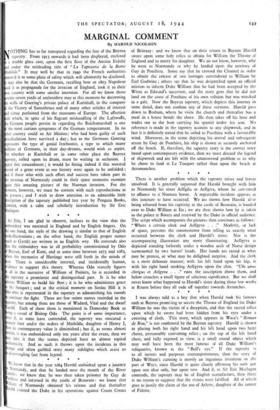We know that in the year 1064 Harold embirked upon
a journey Normandy, and that he landed near the mouth of the River nche: we know that he was then taken prisoner by Guy de onthieu and interned in the castle of Beaurain: we know that illiarn of Normandy obtained his release and that theteafter amid assisted the Duke in his operations against Count Conan
of Brittany: and we know that on their return to Bayeux Harold swore upon some holy relics to obtain for William the Throne of England and to marry his daughter. We do not know, however, why he went to Normandy or why he landed upon the territory of Guy de Ponthieu. Some say that he crossed the Channel in order to obtain the release of two hostages surrendered to William by Earl Godwine ; others say that he was despatched upon an official mission to inform Duke William that he had been accepted by the Witan as Edward's successor, and the ,story goes that he did not land on the coast of Ponthieu of his own volition but was wrecked in a gale. Now the Bayeux tapestry, which depicts this journey in some detail, does not confirm any of these versions. Harold goes down to Bosham, where he visits the church and thereafter has a meal in a house beside the shore. He then takes off his hose and wades out to the boat carrying his spaniel under his arm. No reference is made in the tapestry account to any shipwreck, and in fact it is definitely stated that he sailed to Ponthieu with a favourable wind. Moreover, in the scene depicting his arrival and subsequent arrest by Guy de Ponthieu, his ship is shown as securely anchored off the beach. If, therefore, the tapestry story is the correct story based upon contemporary evidence, then we must discard the legend of shipwreck and are left with the unanswered problem as to why he chose to 'land at Le Touquet rather than upon the beach at Arromanches.
* * * *






















 Previous page
Previous page